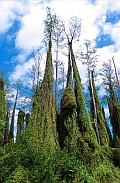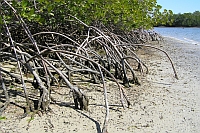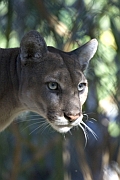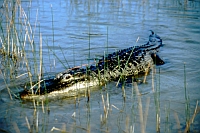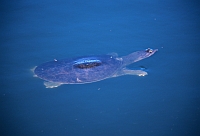Remote Sensing of Natural Heritage Sites
The Everglades National Park, Florida, USA (1/2)
This site at the southern tip of Florida has been called 'a river of grass flowing imperceptibly from the hinterland into the sea'. The exceptional variety of its water habitats has made it a sanctuary for a large number of birds and reptiles, as well as for threatened species such as the manatee.
Flora
The subtropical climate and abundant summer moisture of southern Florida supports rich and varied vegetation in the Everglade National Park with more than 1,000 species of seed-bearing plants, numerous epiphytic plant species, such as bromeliads and orchids, and many others representing more primitive and simply constructed groups, such as ferns, mosses, and lichens. Many plants in the Everglades are found nowhere else on earth.
One of the ecologically most important group of plants in the Everglades are the mangrove forests. Mangroves are evergreen forests in tide-areas of subtropical coasts that grow in brakish and saline water. Their densely interwoven trunks and roots provide a vital habitat for many marine and terrestrial organisms. Mangroves also act to trap and stabilise sediment and reduce the risk of shoreline erosion due to their ability to dissipate surface wave energy.
Fauna
The Everglades provides a sanctuary, as well as a breeding and feeding ground, for many species of wading birds that depend on the climate's wet and dry cycle in order to reproduce.
The Florida Panther tops the food chain preying on deer, wild pigs, birds and hares, but also on crocodiles and alligators. Once common throughout the state, today it is on the verge of extinction.
The alligator is a large reptile called the "king of the Everglades". Without the alligator, the Everglades might not survive. During the dry season (December through April), alligators dig out pockets, or holes, in the limestone.
"Gator holes" are one of the few places in the park where there is standing water during the winter months. These holes become home to many insects, turtles, fish, and wading birds. During the summer wet season, these same animals are spread throughout the "river of grass". At one time an endangered species, the alligator is now making a come back. They are common throughout the fresh water marshes of the park, and occasionally enter the brackish waters of Florida Bay.
Reptiles and amphibians are animals whose body temperature changes with their surroundings (cold-blooded). Everglades National Park, with its semi-tropical climate, is an ideal home for these creatures. There are over fifty species of reptiles found in the park, including twenty-six snakes, sixteen turtles, and several lizards. The eighteen species of amphibians found in the park include the smallest frog in North America, the little grass frog.
Most of the turtles found in the Park live in the fresh water marshes and ponds. At one time, turtles were quite common in the marine environment of Florida Bay. Today, there are fewer marine turtles because their nesting sites have been disturbed.
Many of the snakes found in Everglades National Park are adapted to survive in the water. While most of the snakes living in or near the water are adapted to a fresh water environment, some, like the cottonmouth and mangrove salt marsh snake, can survive in the mangrove swamps and salt water marshes.
